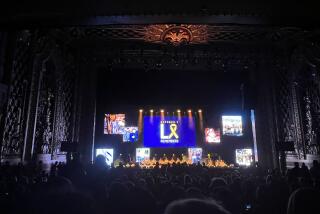THE REYKJAVIK SUMMIT : Jews Pray for Release of Soviet Brethren : Other Religious, Peace and Environmental Activists Also Voice Views
- Share via
REYKJAVIK, Iceland — Pelted by icy rain, Jews clustered around a Torah scroll near the Soviet delegation’s hotel Saturday and prayed for their Soviet brethren in one of several small, scattered demonstrations on the first day of the superpower summit.
The Sabbath service, held shortly after President Reagan and Soviet leader Mikhail S. Gorbachev ended their first meeting, was joined by Icelandic religious groups, who swelled the crowd to about 100.
Icelandic authorities have appealed to demonstrators to stay away from the summit and leave the two leaders alone, and only about 50 Jewish activists from the United States, Europe and Israel have reached the remote island that brushes the Arctic Circle.
Letter From Emigres
The Greenpeace environmental group, peace activists and the Hare Krishna sect also made their presence felt in small ways, and leading Soviet emigre dissidents published an appeal to Gorbachev to free Nobel Peace Prize laureate Andrei D. Sakharov from his internal exile in the city of Gorky.
Led by Yosef Mendelevich, a prisoner in the Soviet Union for 11 years before moving to Israel in 1981, the skull-capped, prayer-shawled worshipers laid a scroll on a table while others held up banners and pictures of Soviet Jews who have been jailed and refused permission to emigrate.
Rabbi Benjamin Lehman of Israel explained that ancient custom dictated that in times of great crisis, Jews should pray in public.
Reykjavik police refused to permit the service in the forecourt of the Saga Hotel, where Soviet officials and journalists were staying. So, the group mustered outside the international press center, 150 yards from the hotel.
‘So Tribal, So Simple’
“This is something so tribal, so simple, that everyone should be allowed to do it,” Lehman said of the outdoor rite. “But our brethren in the Soviet Union are not allowed to do it.”
Jewish students from England had spent the night on the Saga Hotel’s doorstep reading out the names of 11,000 Jews awaiting permission to emigrate.
It was doubtful whether the demonstrations were noticed by Reagan and Gorbachev as they drove by motorcade between their quarters and the Hofdi, the two-story bayside house chosen for the talks.
Both heads of state were under tight security--Reagan at the U.S. Embassy and Gorbachev on a ship brought to Reykjavik harbor.
In another protest, 31 leading Soviet human rights activists of the Toronto-based Committee for Honest Detente published a letter in Iceland’s Morgunbladid newspaper appealing to Gorbachev to free Sakharov.
‘Road to Peace’
“The road to peace runs through Gorky, not through the halls of the KGB,” wrote the signatories, who included recently released activist Yuri Orlov and other major names such as Vladimir Bukovsky, Lev Kopelev, Edward Kuznetsov and Pavel Litvinov.
Also on Saturday, Anatoly F. Dobrynin, a Communist Party secretary and former Soviet ambassador to the United States, agreed to receive three members of a U.S. peace group aboard the Soviet cruise liner docked in the city’s harbor.
David Cortright, executive director of the Committee for a Sane Nuclear Policy, said that he and the two other group members spent 15 minutes with Dobrynin, during which they urged him to seek an extension of the Soviet Union’s unilateral testing moratorium, which expires Jan. 1, 1987.
Greenpeace, the international environmental organization, brought its protest ship Sirius to the Reykjavik harbor approaches, but was refused entry by Icelandic authorities and was forced to go instead to Harnarfjodur, six miles south.
More to Read
Sign up for Essential California
The most important California stories and recommendations in your inbox every morning.
You may occasionally receive promotional content from the Los Angeles Times.












